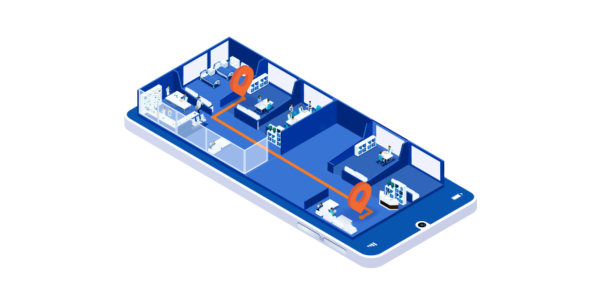Location systems or GPS have become more and more important in our daily lives by simplifying our journeys, regardless of our destination. But what about our movements or the location of objects in buildings? For the past 15 years, indoor geolocation has been making steady progress to provide an effective answer to this question. Let’s take a closer look at this technology with multiple uses.
Indoor geolocation in brief
You may have heard of IPS (indoor positioning system), indoor positioning or indoor geolocation? All these terms are synonymous with indoor geolocation, and refer to a set of technological solutions that allow the location of goods or people in closed spaces (buildings, houses, etc.).
For its implementation, indoor geolocation relies on several location technologies: Bluetooth beacons, RFID chips, Wifi and UWB signals for radio technologies, but also ultrasonic signals or the magnetic field. Depending on their shape and the desired use, they are disseminated in the building or mapped. The signals they emit are then picked up by various mobile devices, such as your smartphone or a touch pad.
Thus, indoor geolocation allows you to establish your position with an accuracy ranging from a few centimeters to several meters depending on the technology used, but also determine the route to take to reach your destination or the object sought.
Why not use a GPS?
Simply because GPS does not work indoors. Yes, this little jewel of technology that allows even those who have no sense of direction to find their way around the world, is unable to orient you in a building located around the corner! Why not?
In order to determine your position outdoors, GPS uses the radio signals emitted by the various satellites orbiting the Earth, but once inside, these signals are blocked by various obstacles (walls, roof, furniture …). The most recent GPS systems do receive a signal indoors, but their accuracy is still insufficient for proper orientation.
The other problem with a traditional GPS is that it processes the signal in a linear fashion, so it can’t determine what floor you’re on. Moreover, its signal decreases as you go downstairs, until it disappears in the basement. Hence the usefulness of an indoor geolocation system.
What are the applications of indoor geolocation?
Whether marketing, commercial or purely practical, the applications of indoor geolocation are numerous:
- Navigation and orientation in a public or private site (airport, hospital, shopping mall…) via a mobile application or a QR code,
- Behavioral analysis and flow optimization in a commercial space or a secured place (industrial site, military complex…),
- Gofencing: sending information to the user when he is in a specific area (promotional offers, security alerts…),
- Interaction with an object in the immediative vicinity (product, work of art…), etc.
The combination of different indoor geolocation technologies is managed via a platform, which can be integrated into the building information system. Sweepin offers innovative, unique and patented indoor geolocation technologies. Discover all our solutions on sweepin.fr.


